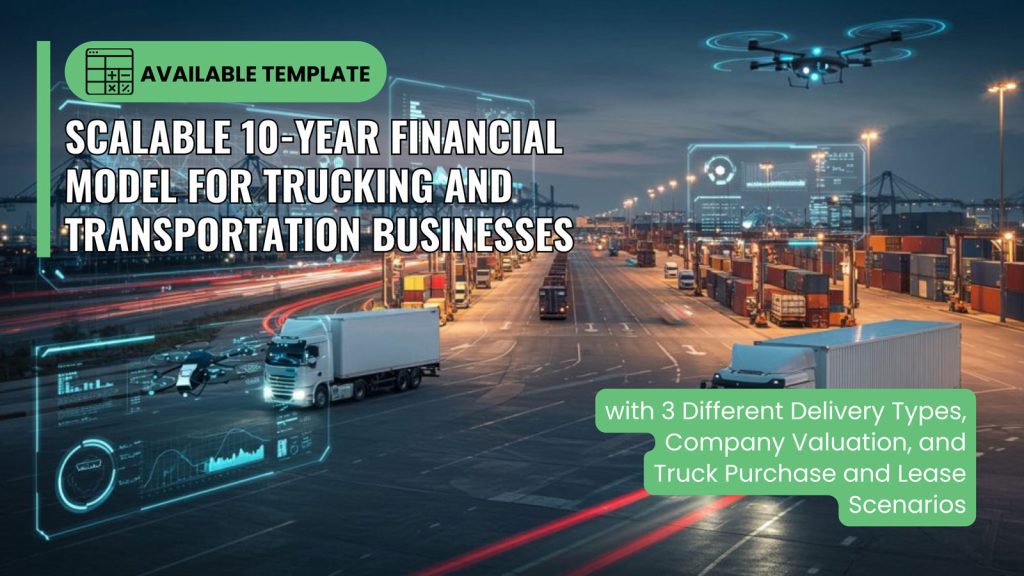
This 10-Year Transport Financial Model Excel Template is a complete, investor-grade forecasting tool for logistics entrepreneurs, fleet owners, and transport companies that need accurate financial projections and valuation metrics.
It transforms your trucking or logistics business plan into a structured financial model that quantifies revenues, expenses, debt, and investment returns.
The model covers every component of a transport operation — fleet acquisition, leasing, depreciation, fuel consumption, maintenance, insurance, and driver wages. Each assumption flows through fully linked financial statements (Incomes, Balance Sheet, Cash Flow) so users can see how daily operating decisions impact profit and cash.
Separate tabs handle CAPEX planning, funding sources, and vehicle replacement cycles, making it ideal for logistics startups and expanding trucking companies alike.
The Best Financial Models transport financial model Excel integrates DCF valuation and IRR analysis, allowing investors to assess return potential under different financing scenarios. Scenario switches help test base, optimistic, and stress cases, revealing liquidity gaps and breakeven points.
Built-in loan schedules project repayments and coverage ratios (DSCR, interest cover) so banks and lenders can instantly evaluate creditworthiness.
For entrepreneurs developing a logistics financial model Excel or a trucking business plan Excel, this template reduces modelling time by weeks while ensuring accuracy and transparency.
Inputs are clearly colour-coded and unlocked for customisation. Users can model up to three transport service types (freight, courier, long-haul), each with unique pricing, capacity, and operating costs.
The logistics financial model outputs comprehensive dashboards and KPIs — EBITDA, IRR, NPV, ROI, profit margin, cash flow, and asset utilisation — all displayed in interactive charts. These visuals make the model a powerful tool for investor presentations, fundraising pitches, and loan applications.
Backed by Best Financial Models’ expertise in transport finance, this Excel template combines depth, clarity, and real-world applicability for any trucking or logistics operation seeking profitable, scalable growth.
| Component | Description |
| Fleet Management and Expansion Planning | Forecasts fleet purchases, leases, resale values, and depreciation schedules. |
| Revenue Per Delivery Type | Supports up to three service types. |
| Comprehensive Cost Modelling | Includes driver wages, fuel, maintenance, tolls, insurance, and administrative costs. |
| Debt and Equity Financing | Simulates loan repayment schedules, funding needs, and investor returns. |
| Break-Even Analysis | Determines the minimum revenue required to achieve profitability. |
| Scenario and Sensitivity Analysis | Tests different pricing models, fleet sizes, and operating costs. |
| Performance Dashboards and Visual Analytics | Provides interactive graphs and key financial metrics. |
| Business Valuation and Exit Planning | Includes Discounted Cash Flow (DCF), IRR, NPV, and ROI calculations. |
| Cash Flow Forecasting | Tracks monthly and annual financial movements to ensure liquidity. |
| Investor Returns Waterfall Model | Calculates how investor profits will be distributed over time. |
| Pre-Populated Mock Scenario | Includes realistic sample data to guide users in applying the model. |
The use of this financial model is solely at the user’s own risk. Best Financial Models provides the template as a tool to assist users in their business planning and decision-making processes. However, the responsibility for adhering to the model’s instructions and guidelines lies entirely with the user. Best Financial Models cannot and will not be held liable for any inaccuracies, errors, or unintended outcomes resulting from the user deviating from the prescribed usage, including but not limited to the deletion, addition, or modification of rows, columns, formulas, or any other components of the model. Users are strongly advised to exercise caution when making any changes to the model to ensure its integrity and reliability are maintained.
| Business Type | Trucking and Transportation |
|---|---|
| File Format | Microsoft Excel |
The transport financial model Excel is a detailed forecasting framework that quantifies the performance of trucking and logistics operations. The BFM Transport Financial Model Excel connects operational inputs—fleet size, mileage, tariffs, fuel, maintenance, and driver costs—to 10-year financial statements, including Income, Balance Sheet, and Cash Flow. Users can calculate IRR, NPV, ROI, and DSCR while modelling debt and equity structures.
This enables fleet operators and logistics entrepreneurs to evaluate profitability, funding capacity, and asset utilisation before expanding or seeking finance. Built for transparency, the model provides investor-grade accuracy, ensuring every projection aligns with bank and investor requirements for credible logistics and transport financial planning.
The BFM Transport Financial Model Template combines robust financial logic with a user-friendly design. It features linked income, balance sheet, and cash flow modules; CAPEX scheduling for vehicle purchases or leases; and automated loan amortisation and depreciation tables. Users can model up to three service lines—freight, courier, and long-haul—and analyse margins for each.
Valuation dashboards compute IRR, NPV, payback period, and equity returns. Scenario switches test base, optimistic, and conservative outcomes, helping founders assess liquidity and break-even points. The logistics financial model Excel is fully editable and colour-coded, making it ideal for logistics start-ups, SMEs, and established transport businesses pursuing growth or investor funding.
The trucking financial model Excel forecasts income by linking fleet utilisation, trip distance, and pricing to each service type. Users input tariffs, loads, and fuel efficiency to calculate monthly and annual revenues. Operating costs—fuel, maintenance, tolls, wages, and insurance—are dynamically generated per vehicle and period.
These figures flow through to 10-year forecasts, producing analyses of gross margin, EBITDA, and profit. The transport financial model template then consolidates all results into clear dashboards. Entrepreneurs can run “what-if” scenarios, adjust routes or costs, and instantly view profitability impacts, ensuring their trucking or logistics business plan remains grounded in measurable, data-driven assumptions.
Yes. The transport financial model Excel includes detailed loan modules, interest schedules, and covenant tests such as DSCR and debt-to-equity ratios. These allow banks to assess repayment capacity and investors to measure returns through DCF valuation and IRR metrics. The BFM Transport Financial Model Template outputs lender-ready cash-flow forecasts and sensitivity charts that quantify risk.
Whether raising start-up capital or refinancing a fleet, entrepreneurs can use this logistics startup financial model to demonstrate project feasibility, justify funding requirements, and communicate performance expectations with professional precision.
The BFM Transport Financial Model Excel automatically calculates IRR, NPV, ROI, payback period, EBITDA margin, DSCR, and cost-per-kilometre. It tracks fleet utilisation, fuel cost ratios, and revenue per vehicle to benchmark operational efficiency. KPIs appear on dynamic dashboards alongside profit, cash, and leverage metrics.
For users of financial models for trucking and logistics, these insights highlight margin trends and capital productivity. Investors can quickly assess project sustainability, while managers use the results to improve cost control and pricing. By standardising KPIs over a 10-year horizon, the model ensures consistency in analysis across multiple transport divisions.
Absolutely. The BFM Transport Financial Model Excel is designed for scalability. Users can modify fleet size, routes, vehicle types, or pricing to fit small courier start-ups or national haulage companies. It supports additional revenue streams—such as warehousing, third-party logistics, or fuel distribution services—without breaking the formulas. Because every sheet is interconnected, adjustments are applied to all statements instantly.
The logistics financial model Excel can be localised for regional operations or expanded for global franchises. This flexibility makes it an essential forecasting and valuation tool for any transport or trucking entrepreneur building investor-ready business plans.
A dedicated fleet-management section within the transport financial projection template allows users to forecast acquisitions, leases, depreciation, and disposal values. Vehicle replacements can be scheduled over the 10-year horizon to maintain optimal fleet age. The trucking financial model in Excel automatically updates CAPEX, depreciation expense, and cash flow implications for each asset.
By linking these to profitability and financing modules, the BFM Transport Financial Model helps operators manage long-term capital expenditure and ensure sustainable asset cycles. The result is a precise understanding of when to reinvest, refinance, or retire trucks for maximum operational efficiency.
Beyond strategy, the logistics financial model Excel functions as a real-time budgeting system. Operators can input monthly actuals to compare against forecasts and analyse cost variances for fuel, repairs, or wages. Dashboards highlight deviations, helping management take corrective action.
The model’s colour-coded structure simplifies updates, while the integrated KPIs keep budgets aligned with profitability goals. For SMEs and growing fleets, this trucking business plan Excel acts as both a planning and control tool—supporting financial discipline, cost optimisation, and evidence-based decision-making across the entire transport business.
The transport financial model Excel uses the Discounted Cash Flow (DCF) methodology to estimate enterprise and equity values based on projected free cash flows. It calculates IRR, NPV, and payback period for base, upside, and downside cases. Valuation dashboards display results alongside sensitivity tables for fleet size, tariffs, or financing changes.
The BFM Transport Financial Model Template provides investors with a clear picture of return potential and risk exposure, while helping entrepreneurs justify valuations during negotiations or fundraising.
The Best Financial Models Transport Financial Model Excel merges professional-grade financial logic with a user-friendly design. It includes 10-year forecasts, integrated 3-statement reporting, valuation tools, and scenario analysis. Developed by experts in financial modelling, it is trusted by logistics startups, trucking companies, and investors worldwide.
The workbook’s transparency, colour-coded inputs, and dashboards ensure credibility and clarity. For entrepreneurs preparing a logistics or trucking business plan in Excel, this model provides the foundation for bankable projections, strategic insights, and long-term profitability.
Need another Financial Model Template?
Visit our BFM Financial Model Template Store
Plan and scale your logistics operations with confidence.
Forecast revenues, fleet growth and profitability with a bank-ready model trusted by entrepreneurs and investors.
The 10-Year Transport Financial Model Excel Template is a complete, investor-grade forecasting tool for logistics entrepreneurs, fleet owners, and transport companies that need accurate financial projections and valuation metrics.
It transforms your trucking or logistics business plan into a structured 10-year financial model that quantifies revenues, expenses, debt, and investment returns.
This transport financial model covers every component of a transport operation — fleet acquisition, leasing, depreciation, fuel consumption, maintenance, insurance, and driver wages. Each assumption flows through fully linked financial statements (Incomes, Balance Sheet, Cash Flow) so users can see how daily operating decisions impact profit and cash.
Separate tabs handle CAPEX planning, funding sources, and vehicle replacement cycles, making it ideal for logistics startups and expanding trucking companies alike.
R2,499.00
We accept various methods of payment, including Visa, Mastercard, and EFT.
Our site is secured with SSL certification and we do not store any of your payment details.
Immediate access to your chosen financial model, compatible with Excel or Google Sheets.
Our templates are designed for global use, featuring support for all major currencies.
Do you need a Tailored Transportation Business Plan? Trust Africa’s Leading Business Plan Company, JTB Consulting—your expert freight and logistics partner since 2006.
We don’t spam, and you can always opt out at any time.
